Slotting in nicely with Microsoft’s Xbox/IPTV Announcement (You’ll be able to watch IPTV through your Xbox toward the end of the year), Just the Beginning, says The Diffusion Group.

A surge in the availability of high-quality web-based video content and the proliferation of solutions that network-enabled TVs will usher in a ‘new wave’ of television viewing, one defined less by ‘walled garden’ PayTV operators and more by open access and a variety of highly-specialized niche content.
According to Broadband Video: Redefining the Television Experience, The Diffusion Group’s latest report on IP media, the number of broadband-enabled TVs – those capable of directly or indirectly receiving broadband video content – is expected to exceed 162 million households globally by 2011.
“It is fair to say that the democratization of video delivery is officially underway,” noted Colin Dixon, senior analyst and author of the report. “As the Internet finds its way to the primary home TV – and it will – incumbent PayTV operators and established broadcasters will gradually lose control over the types of video consumers can watch. In the next few years, a growing number of consumers will look to the Internet as means of expanding the variety of content to which they have access, much of which will be available on-demand and specifically suited to their tastes.”
Dixon mentions five factors which in combination are creating a ‘tipping point’ for broadband TV including:

- The widespread adoption of broadband Internet service;
- The expanding variety of video content available on the Internet;
- The introduction and push of solutions intended to enable Internet video viewing on the TV (such as Microsoft’s Xbox/IPTV platform and Apple’s pending iTV adapter);
- The entry of top-tier content producers into the Internet marketplace, many of which are now pushing high-value franchise content onto the web; and
- The move from short-form ‘snack’ Internet video content to full-length TV programming and movies.
- The impact of these trends remains lost on the vast majority of video entities. As Dixon states, “While the subject of Internet video is on everyone’s tongue, very few have a full understanding of how Internet-based video will impact the traditional TV business.”
In many cases, consumers will simply use a proxy to enable an Internet-to-TV connection – that is, instead of having a modem embedded in the TV which connects directly to a broadband service, consumers will use an Internet television adapter, or iTVA, such as a Internet-enabled game console, media-centric PC, digital media adapter, or hybrid set-top box to access web-based video content.
Dixon notes that for those with a broadband Internet connection, it is becoming quite simple to both provide and access Internet-based video on the living room TV. “Not only is it now technologically feasible for most consumers, but economically attractive for content providers.” In other words, the value proposition is both supply- and demand-driven.
As well, the Internet video space is undergoing a shift away from short ‘video snacks’ and toward longer form narrative content more characteristic of TV in terms of production quality, video quality, and length.
Broadband Video: Redefining the Television Experience is TDG’s latest report on the digital home and IP media. In addition to expanding greatly on the themes illuminated in TDG’s free white paper, The Emergence of Broadband Television, the full report explores in detail how many broadband-enabled televisions will actually be connected to the Internet and used to receive broadband video. Further, the report discusses the types of video services that will be launched from the Internet targeting the television and includes specific revenue estimates for these servic es. The report also looks at the barriers to open access to Internet from the television and how these barriers will be overcome.
 Employing a carousel-style interface, the application comes with Yahoo! Go ‘widgets’ offering e-mail, local information and maps, news, sports, finance, entertainment, weather, photo sharing and search functionality.
Employing a carousel-style interface, the application comes with Yahoo! Go ‘widgets’ offering e-mail, local information and maps, news, sports, finance, entertainment, weather, photo sharing and search functionality. Yahoo! Go also makes it easy to get to other websites, without the need to faff about with al that fiddly http://www stuff – just type in the name of a website and you’ll be taken to the site.
Yahoo! Go also makes it easy to get to other websites, without the need to faff about with al that fiddly http://www stuff – just type in the name of a website and you’ll be taken to the site.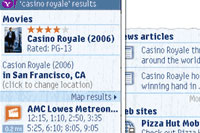 News, Sports, Entertainment, Weather and Finance info can accessed via various widgets, with the ability to add new content via customised RSS feeds.
News, Sports, Entertainment, Weather and Finance info can accessed via various widgets, with the ability to add new content via customised RSS feeds.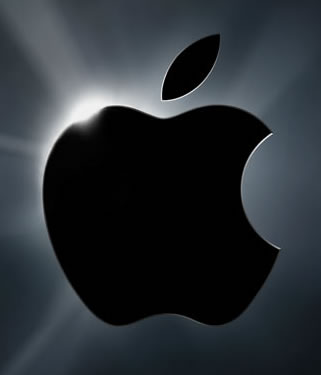 OK, we all know the details now. Apple are releasing a phone – and it’s a looker. Hurrah.
OK, we all know the details now. Apple are releasing a phone – and it’s a looker. Hurrah.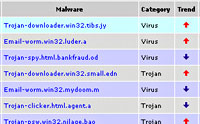 In ye olde days, spammers just used to send out bucket loads of text-based emails, but these were proving progressively less effective against smarter anti-spam software employing tricks such as dictionary-based content filters.
In ye olde days, spammers just used to send out bucket loads of text-based emails, but these were proving progressively less effective against smarter anti-spam software employing tricks such as dictionary-based content filters.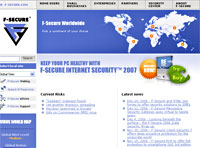 All spam is annoying, but with its bundled images, this new technique adds a double whammy of gobbling up more precious bandwidth to deliver its spam-tastic cargo.
All spam is annoying, but with its bundled images, this new technique adds a double whammy of gobbling up more precious bandwidth to deliver its spam-tastic cargo.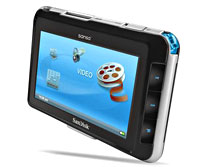 Measuring up at a pocketable 78.5mm x 123mm x 16.9mm, the flash-based player comes with a large 4″ widescreen display and can display photos up to 16 megapixels, making it handy for photographers on the move.
Measuring up at a pocketable 78.5mm x 123mm x 16.9mm, the flash-based player comes with a large 4″ widescreen display and can display photos up to 16 megapixels, making it handy for photographers on the move. External storage options come in the shape of a slot for SD and the new SD High Capacity (SDHC) cards.
External storage options come in the shape of a slot for SD and the new SD High Capacity (SDHC) cards.

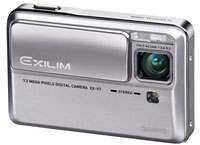 Skinnier than an anorexic stick insect in need of a snack, Casio has unveiled what it claims is the “slimmest digital camera with a 7X optical zoom lens” in the known universe, the Exilim EX-V7.
Skinnier than an anorexic stick insect in need of a snack, Casio has unveiled what it claims is the “slimmest digital camera with a 7X optical zoom lens” in the known universe, the Exilim EX-V7. This is backed up by some software wizardry which works out the speed and vector of a moving subject and then sets the most appropriate ISO sensitivity and shutter speed automatically.
This is backed up by some software wizardry which works out the speed and vector of a moving subject and then sets the most appropriate ISO sensitivity and shutter speed automatically.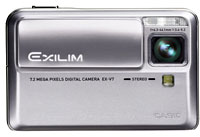 The EX-V7 comes with a 2.5-inch, 230k LCD screen, a max sensitivity of ISO 1600 (in High Sensitivity mode) and can take around 240 shots on a single charge of its Li-ion battery.
The EX-V7 comes with a 2.5-inch, 230k LCD screen, a max sensitivity of ISO 1600 (in High Sensitivity mode) and can take around 240 shots on a single charge of its Li-ion battery. The open source Mozilla Firefox browser enjoyed a whopping increase of nearly 50% during 2006, according to Web measurement firm, Net Applications
The open source Mozilla Firefox browser enjoyed a whopping increase of nearly 50% during 2006, according to Web measurement firm, Net Applications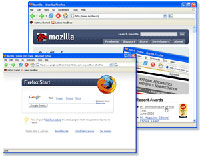 For every winner there has to be a loser or two, and in this case it was Microsoft, who saw their market share slump to 79.6% from 85.1% at the start of 2006, despite the release of an update to Internet Explorer last year.
For every winner there has to be a loser or two, and in this case it was Microsoft, who saw their market share slump to 79.6% from 85.1% at the start of 2006, despite the release of an update to Internet Explorer last year. Elsewhere, Opera grew its share to match Netscape, up from 0.6% at the beginning of the year.
Elsewhere, Opera grew its share to match Netscape, up from 0.6% at the beginning of the year.